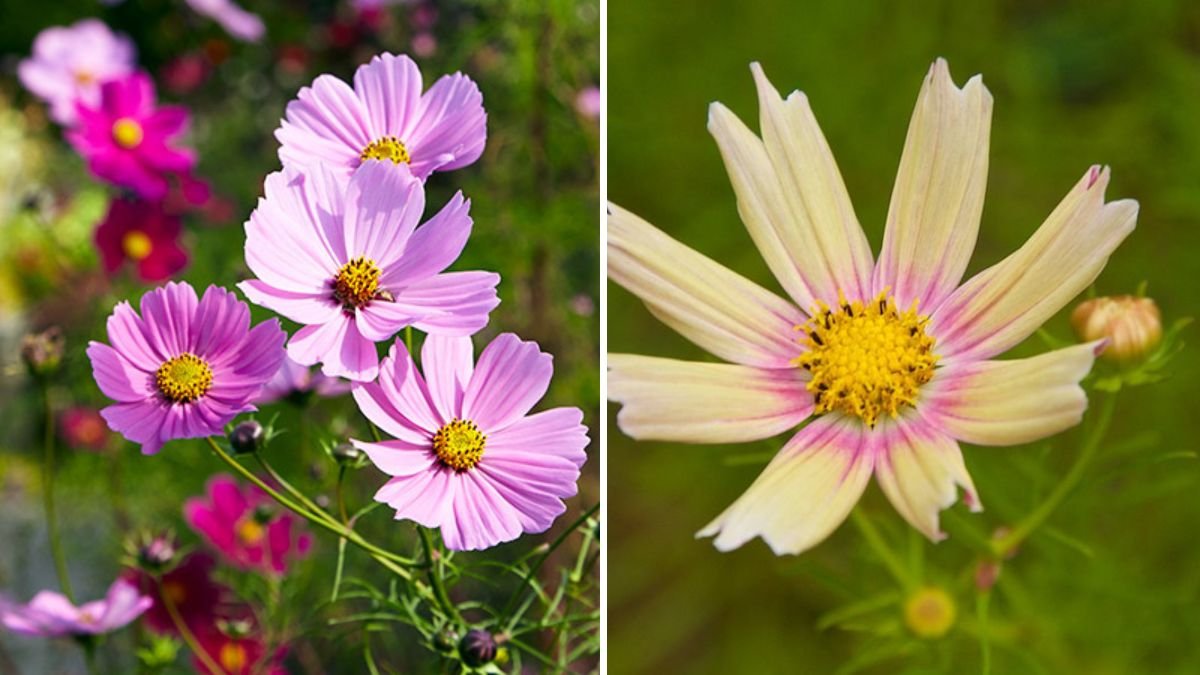Cosmos flowers are a favorite among gardeners seeking a wildflower, carefree aesthetic. Their delicate, daisy-like blooms, tall airy stems, and vibrant colors—ranging from pinks and purples to reds and whites—make them perfect for creating a charming cottage garden look. Cosmos are easy to grow, low-maintenance, and attract pollinators, adding life and movement to your garden space.
This guide covers how to grow cosmos successfully, including site selection, soil preparation, sowing techniques, care, companion planting, and design ideas to achieve a bountiful, whimsical cottage garden.
1. Why Cosmos Are Ideal for Cottage Gardens
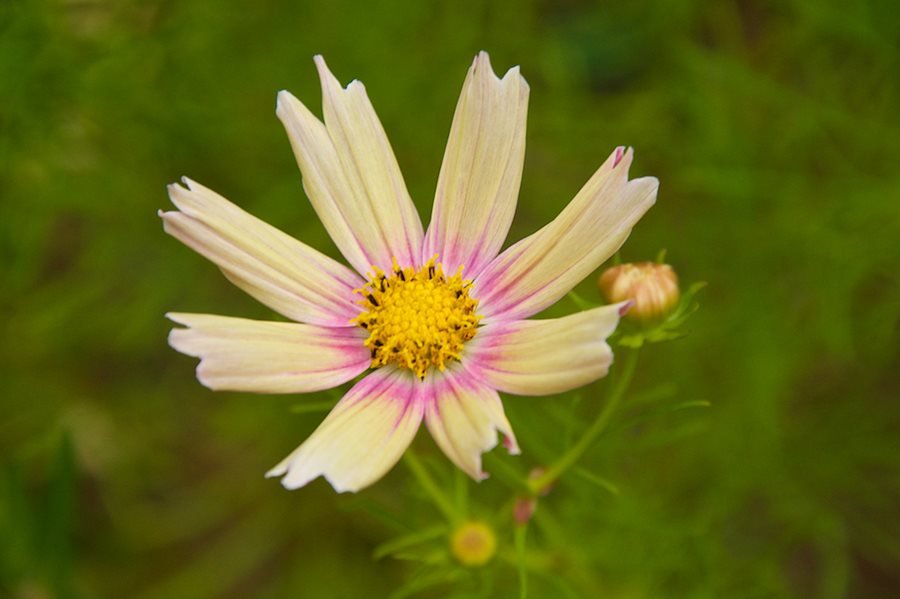
Cosmos plants naturally lend themselves to the relaxed, colorful style of cottage gardens:
- Tall, airy stems create movement and a soft, flowing backdrop.
- Vibrant, cheerful blooms provide continuous color throughout the growing season.
- Pollinator-friendly: Attract bees, butterflies, and even birds.
- Low-maintenance: Tolerant to poor soil and drought conditions once established.
- Self-seeding: Cosmos readily reseed, creating a natural, abundant look year after year.
Tip: Mixing cosmos with other cottage-style flowers like hollyhocks, foxgloves, and larkspur enhances the naturalistic aesthetic.
2. Choosing the Right Variety of Cosmos
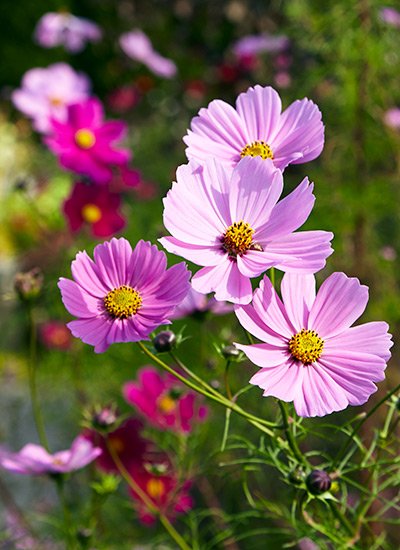
Several varieties suit cottage garden settings:
- Cosmos bipinnatus: The most common type, featuring finely divided foliage and blooms in pink, white, and red. Ideal for borders and mixed beds.
- Cosmos sulphureus: Produces bright yellow or orange flowers, adding a sunny, cheerful tone. Hardy and compact, suitable for containers and mass planting.
- Cosmos ‘Candy Stripe’ or ‘Sensation Mix’: Variegated and multicolored varieties that enhance visual interest.
Tip: Combine tall and shorter varieties to create layers and depth in your garden design.
3. Site Selection and Sunlight
Cosmos thrive in full sun and well-draining soil. Key considerations include:
- Sunlight: At least 6–8 hours of direct sunlight daily.
- Wind Protection: Plant in a sheltered spot to prevent tall stems from snapping.
- Soil: Cosmos prefer light, sandy, or loamy soil. Avoid overly rich soil, which can produce excessive foliage at the expense of flowers.
Tip: Raised beds or borders near walkways work well to showcase cosmos blooms and provide easy access for deadheading and maintenance.
4. Soil Preparation and Fertilization
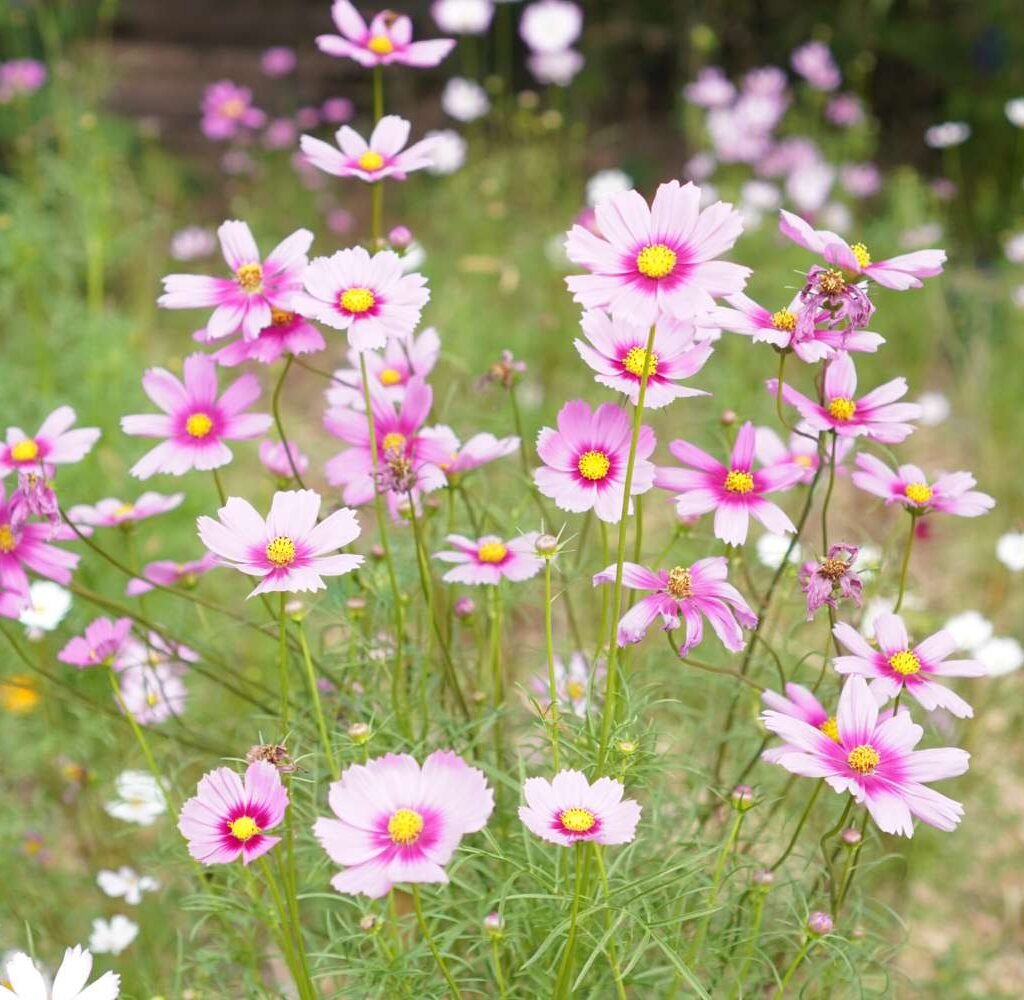
Proper soil preparation ensures healthy growth:
- Light and Well-Draining: Cosmos tolerate poor soil, but loose soil encourages strong roots.
- Moderate Fertility: Avoid heavy fertilizers; too much nitrogen leads to lush leaves but fewer flowers.
- Organic Matter: Mix in compost or aged manure for a light nutrient boost without overfeeding.
Tip: A slightly acidic to neutral pH (6.0–7.0) is ideal for cosmos.
5. Sowing Cosmos Seeds
Cosmos are best grown from seeds for a natural cottage garden appearance:
- Direct Sowing: Sow seeds outdoors after the last frost date. Scatter seeds in the desired area and lightly cover with ¼ inch of soil.
- Indoor Sowing: Start seeds 4–6 weeks before the last frost in seed trays. Transplant seedlings when they reach 3–4 inches tall.
- Spacing: Sow seeds 12–18 inches apart for tall varieties, 8–12 inches for shorter varieties.
- Watering: Keep soil consistently moist until germination, which occurs in 7–14 days.
Tip: Cosmos self-seed easily, so leave some spent flowers to dry on the plant for natural reseeding.
6. Watering and Mulching
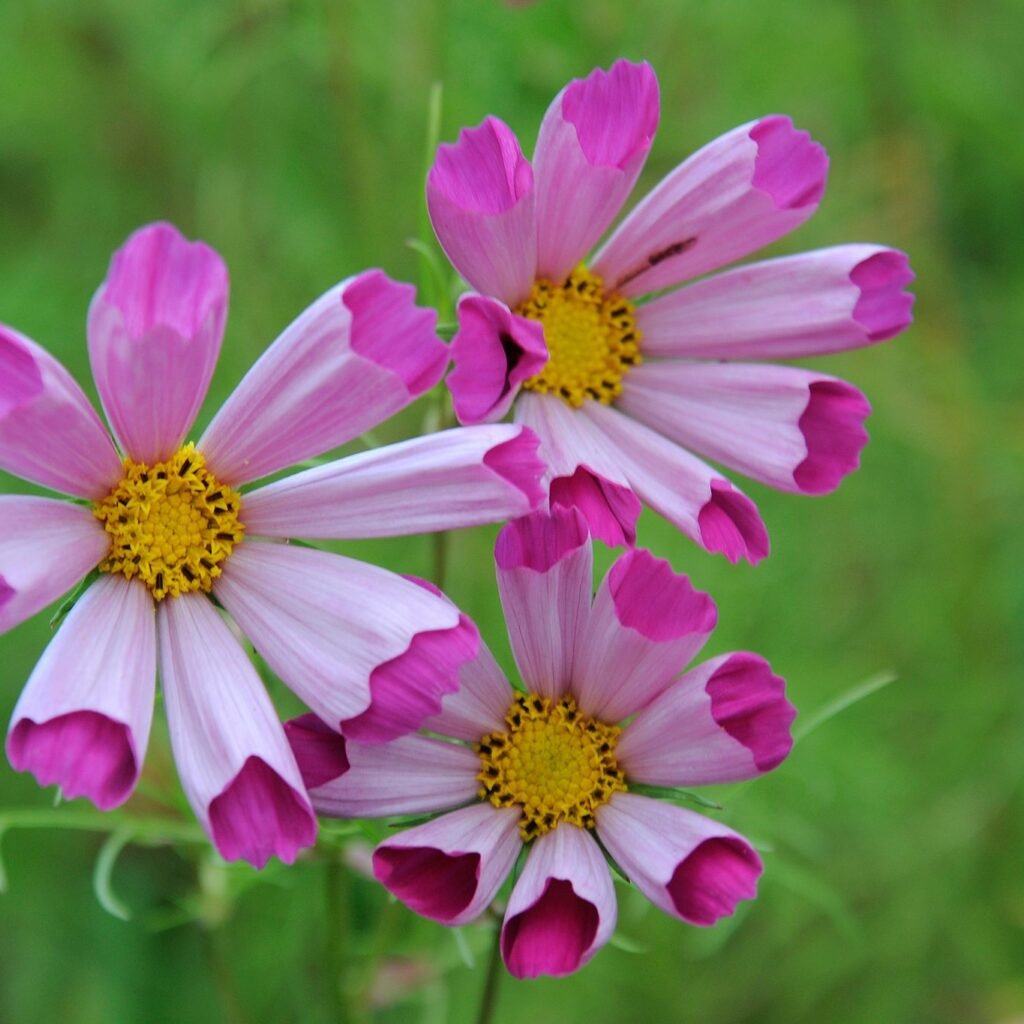
Once established, cosmos are drought-tolerant, but young plants need regular watering:
- Watering Frequency: Water moderately; avoid overwatering to prevent root rot.
- Mulching: Use straw or shredded leaves to retain soil moisture, suppress weeds, and enhance the rustic garden look.
Tip: Avoid excessive mulch directly against stems to prevent fungal growth.
7. Staking and Support
Tall cosmos varieties may need support to prevent flopping:
- Staking: Use bamboo stakes or decorative trellises for taller varieties.
- Grouping: Plant in clusters; the weight of multiple stems can provide natural support.
- Wind Protection: Choose a sheltered spot or use a garden netting to reduce wind damage.
Tip: Tall cosmos add height and movement when swaying in the breeze, enhancing the cottage garden feel.
8. Fertilization and Care During Growth
Cosmos require minimal care but benefit from occasional attention:
- Fertilization: Use a balanced, low-nitrogen fertilizer if needed. Excessive fertilization reduces flower production.
- Deadheading: Regularly remove spent blooms to encourage continuous flowering.
- Pest Control: Generally pest-free; monitor for aphids and spider mites. Use natural solutions like neem oil if needed.
Tip: Cosmos tolerate neglect, making them ideal for low-maintenance cottage gardens.
9. Companion Planting for a Cottage Garden Look
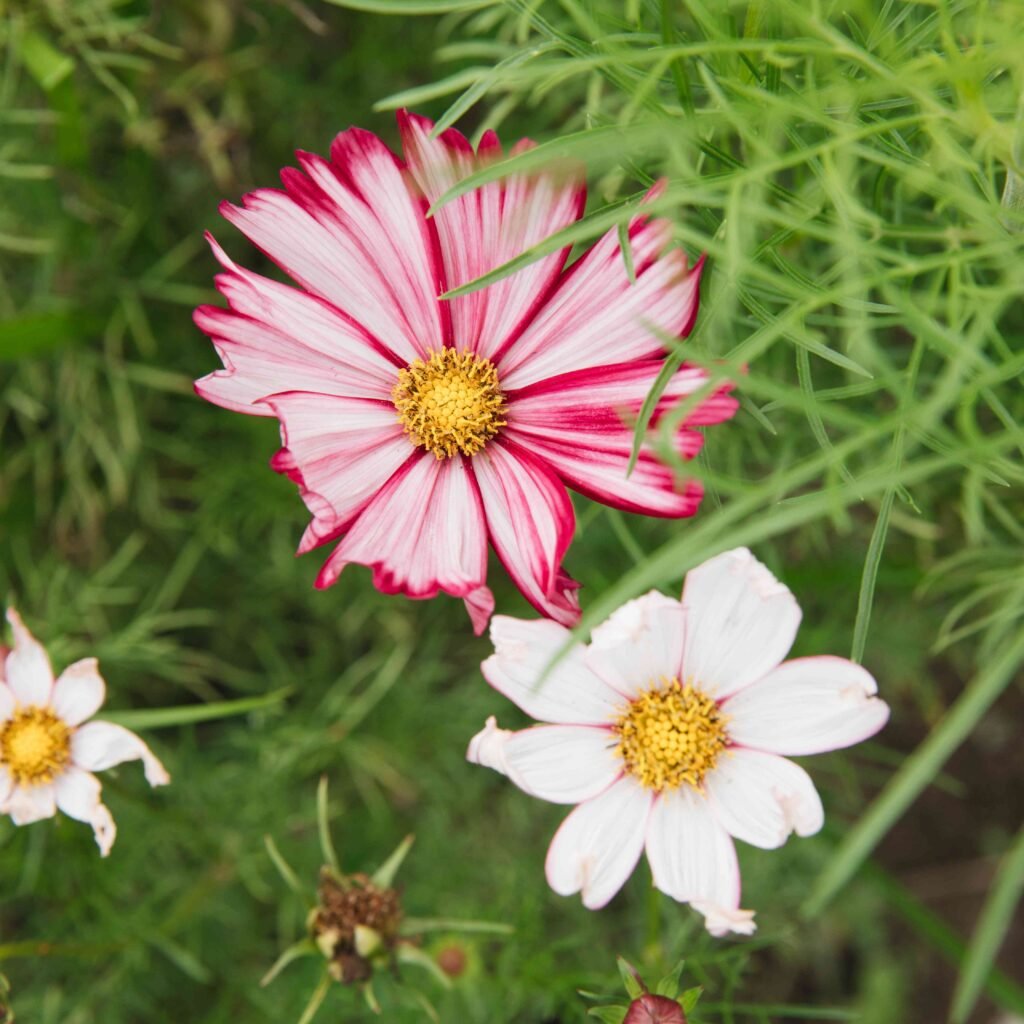
Mixing cosmos with other flowers enhances color, texture, and charm:
- Tall Backdrops: Hollyhocks, foxgloves, delphiniums.
- Mid-Height Fillers: Coreopsis, zinnias, rudbeckia.
- Ground Covers: Sweet alyssum, creeping thyme, or lobelia.
- Foliage Contrast: Ferns, ornamental grasses, or hostas.
Tip: Aim for a natural, informal layout, scattering flowers rather than planting in rigid rows for a true cottage garden style.
10. Seasonal Care and Maintenance
Cosmos are annuals, but careful care maximizes blooms:
- Spring: Sow seeds or transplant seedlings; ensure proper sunlight.
- Summer: Water regularly during dry periods; deadhead for prolonged blooming.
- Autumn: Allow some flowers to go to seed for natural reseeding next year.
- Winter: Remove dead stems and prepare beds for spring sowing.
Tip: Companion planting with herbs and perennials ensures year-round interest even after cosmos fade.
11. Design Tips for a Cottage Garden Look
To achieve a quintessential cottage garden:
- Layering: Use a mix of tall, medium, and low plants for depth.
- Curved Beds: Avoid straight lines; natural curves and informal groupings look more charming.
- Color Harmony: Combine pinks, whites, and purples for a soft romantic palette. Add occasional bright splashes for vibrancy.
- Wildflower Mixes: Integrate cosmos with other self-seeding wildflowers for an effortless, natural feel.
- Pathways: Plant along pathways or edges for a welcoming, whimsical touch.
Tip: Incorporate decorative elements like rustic trellises, wooden benches, or stone paths to enhance the cottage ambiance.
Conclusion
Growing cosmos is a simple and rewarding way to add charm, color, and natural beauty to your garden. Their tall, airy stems, vibrant flowers, and low-maintenance nature make them ideal for creating a relaxed, romantic cottage garden look.
Key takeaways:
- Choose the right cosmos varieties for height, color, and bloom style.
- Plant in sunny, well-draining locations with light, moderately fertile soil.
- Sow seeds directly or start indoors for early blooms.
- Water moderately and mulch to retain moisture.
- Provide staking or group planting for support.
- Deadhead spent flowers to encourage continuous blooming.
- Monitor for pests naturally and avoid chemical interventions.
- Use companion planting and layering for visual depth and color contrast.
- Embrace informal planting patterns and curved beds for a natural look.
- Allow some flowers to self-seed for effortless future growth.
With thoughtful planting and minimal care, cosmos can transform any garden into a lively, colorful, and quintessentially charming cottage retreat, inviting pollinators and delighting gardeners season after season.
